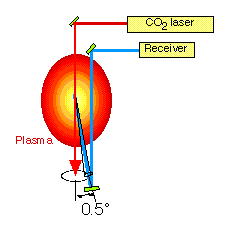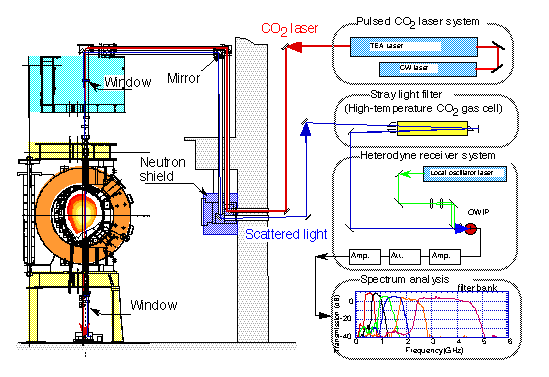Objectives
Though fusion generated alpha particles play an important role in plasma heating and alpha-driven instabilities, an effective measurement method has not been established yet. A collective Thomson scattering diagnostic system using a carbon dioxide (CO2) laser has been developed for the purpose of establishing measurement technique of fast alpha particles and ion temperature in a fusion reaction plasma in collaboration with Oak Ridge National Laboratory.
Diagnostic Method
Ions do not interact strongly with CO2 laser but collective motion of the electron which is drawn by ions can scatter the laser. Ion velocity distribution is evaluated by measuring Doppler shift of the scattered light of CO2 laser in the plasma. It is necessary to choose a small scattering angle to that a scattering wave length may be larger than Debye length.

Fig.1 Schematic view of the scattering geometry
[Specifications]
| CO2 laser | Wave length : 10.6mm Energy : 15J Pulse width : 1ms Repetition late : 2s Divergence : 0.5mRad Diameter : 4cm |
| Stray light notch filter (Hot CO2 gas cell) |
Attenuation : 10-4 - 10-7 (10.6mm) Width : ~ 500MHz Temperature : ~ 400°C |
| Heterodyne receiver | Noise equivalent power : 9×10-19 W/Hz Band width : ~8 GHz |

Fig. 2 Schematic view of the Collective Thomson scattering system
References
[1] T. Kondoh, S. Lee, D.P.Hutchinson, R.K.Richards, Rev. Sci. Instrum. 72, 1143 (2001)
[2] T.Kondoh, S.Lee. Y.Miura, J. Plasma Fus. Res.76, 883 (2000) (in Japanese)
[3] S. Lee, T. Kondoh, Rev. Sci. Instrum, 71,3718(2000)
[4] S. Lee, T. Kondoh, Y. Yonemoto, Y. Miura, Rev. Sci. Instrum, 71, 4445 (2000)

